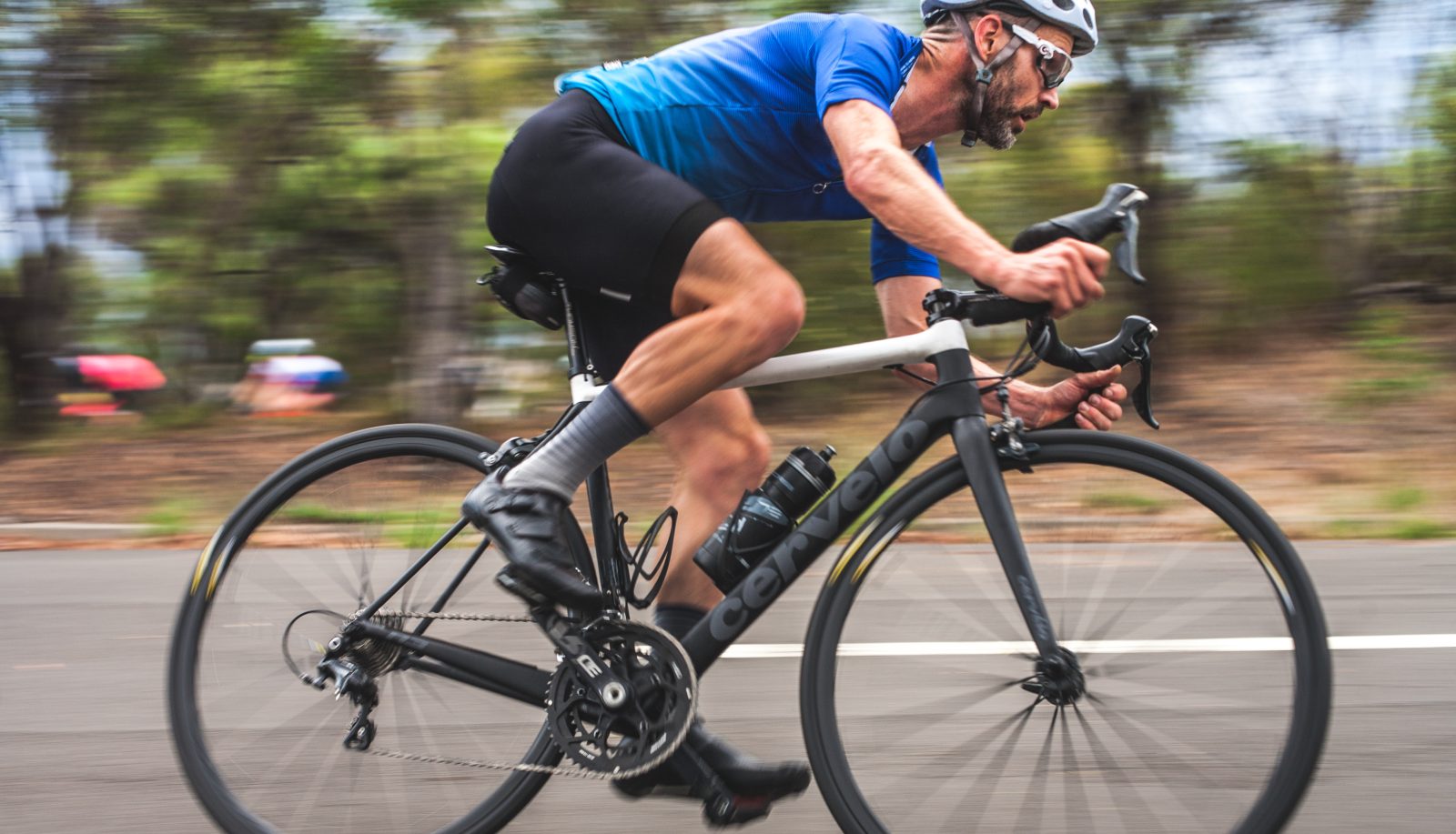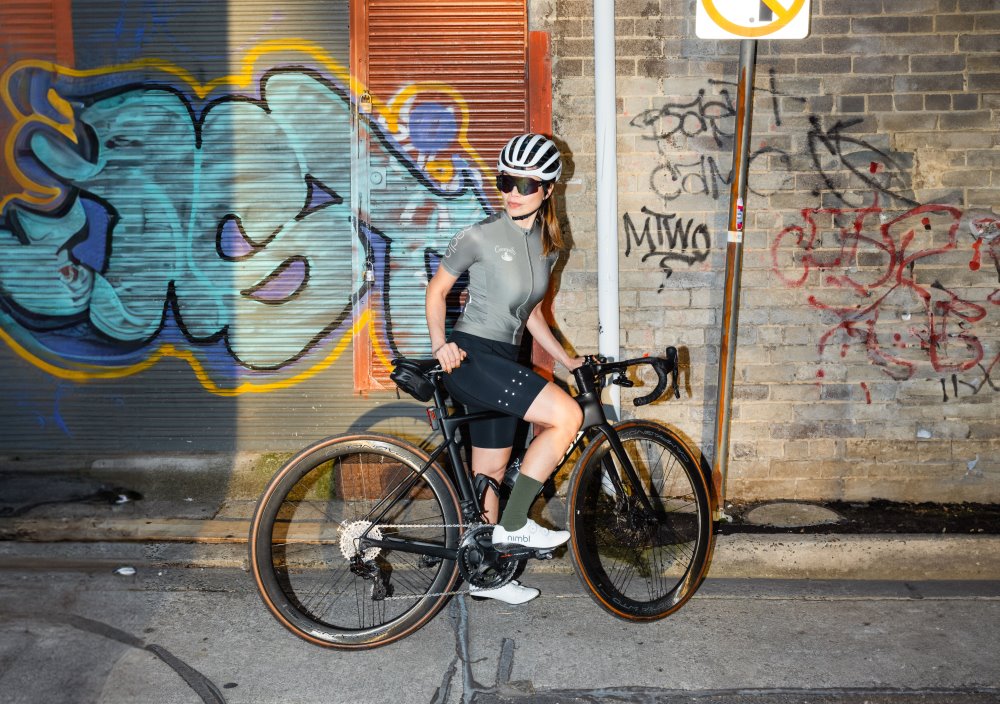On International Women’s Day 2023, Switzerland Tourism launched the 100% Women cycling campaign, which aims to get women out of their comfort zone to embark on their next cycling adventure in one of the world’s true cycling meccas.
Cyclist headed over this European summer for a multi-day wow-fest of a tour that included road, gravel, MTB and even a gran fondo

Words FARINAZ ZAMANI Photography FLORENCE GROSS
I’ve just sat down at the dinner table with a plate full of cheese and I have zero pangs of guilt. I take a big gulp of my delicious wine and marvel at the various types of Swiss cheese in front of me.
It’s been one hell of a day. Less than six hours ago I was riding up one of the greatest hairpin-cobblestone combination climbs in the world. I can still feel the vibrations in my wrists from when my bike was clattering over the jagged stones like a speedboat on choppy water.
‘You feeling okay?’ I snap out of my cobblestone reflections and smile at Elke (from Belgium) sitting next to me. ‘Mate, I’m on top of the world!’ I reply. She laughs and puts her arm around me. ‘You should say something to the group!’ she says.
I hesitate. ‘C’mon. We’ll do it together.’ She grabs my hand and pulls me up in front of everyone. It’s my fourth day in Switzerland and, so far, I have ridden up endless mountains, through roads between giants, crossed lands of another world and rode next to glaciers and eternal rivers.
Sharing this two-wheeled epic adventure across Switzerland with me are 18 sensational and diverse women from around the globe.
We’ve all been invited by Switzerland Tourism to partake in a 100% Women initiative, which aims to provide more opportunities for women in outdoor sports and inspire them to get involved in new sporting opportunities.
Over the course of six days, we get out of our comfort zones and embark on an adventure that sees us on road bikes, gravel bikes and MTBs in one of the world’s most perfect cycling playgrounds.

Pedalling for progress
According to a 2022 survey conducted by the Swiss government, a total of 1.25 million women in Switzerland regularly cycle or go mountain biking in their free time. If you’ve ever been to this cycling paradise you’ll understand why you would want to spend all your free time outdoors.
It’s no surprise cycling tourism in Switzerland has generated an annual turnover of three billion Swiss francs in 2021 alone.
Swiss Tourism has taken a strong step forward in gender equality by helping get even more women from all around the world into cycling by promoting competitive female-only cycling packages in Switzerland.
Since its inception some three years ago, the 100% Women Initiative has focused on hiking and mountaineering. 2023 has been announced as the year the 100% Women Initiative focuses on promoting cycling to a female audience.
On 8 March, International Women’s Day, Switzerland Tourism launched over 50 guided female-only cycling packages for 2023 with the help of key Swiss tourism partners.
These packages, published on the 100% Women’s Travel Hub, showcase Switzerland’s diversity as a national and international cycling destination, demonstrating the accessibility and appeal of its many roads and trails, whether for road cycling, mountain biking, gravel biking or e-biking.
All these packages are bookable immediately and take place over the Swiss cycling season, which begins in the European spring. The options range from one-day to multiple-day trips and include beginner cyclist, training, cycle and flop, e-biking, technical and racing packages.
And so, in this issue, our Big Ride gets a Swiss makeover and gives you a little taste of the different cycling options available on the 100% Women’s Travel Hub.
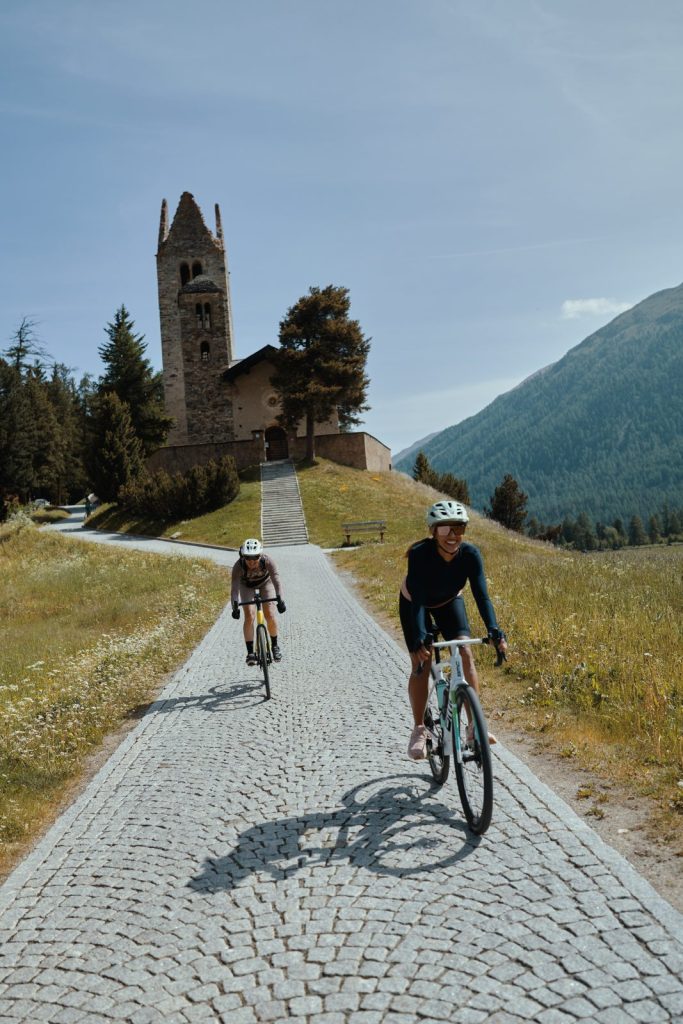
Day 1: Ready, steady, flow!
Since I started cycling some eight years ago, I’ve dabbled in mountain biking a handful of times, and although I respect the thrills associated with this off-road cycling discipline, I’ve always preferred my skinny tyres.
When I found out the very first day of our 100% Women Cycling Challenge would be on an MTB, I immediately started to think about how I could skip thatday. Don’t judge me.
But after a lot of mental gymnastics and reassuring chats with our very patient guides, I pulled on my elbow and knee pads and turned off my adult brain. Our day started in St Moritz, which is best known for its thermal spas, curling, ice-polo and skiing.
That said, hidden beneath this glitzy veneer is some very down ’n’ dirty, world-class mountain biking that should be on every mountain biker’s bucket list.
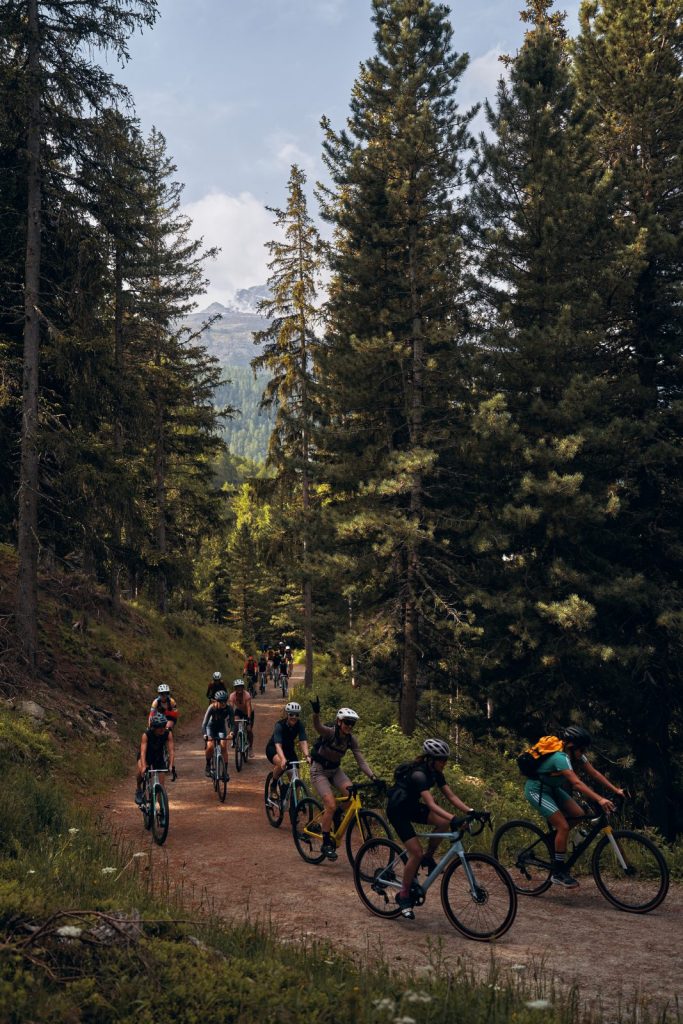
St Moritz’s 10-year investment in mountain biking is clear to see in both a bubbling bike-vibe that’s centred on a vast trail network of both bermed flow trails and natural singletrack, all well-signed and delivering big adventure rides or quick gravity hits alike.
Following a much-needed session with certified MTB guides on riding techniques at the base of the Alps, we find ourselves accessing the main trail hub on the lung-challenging 2,486-metre-high Corviglia via a two-stage mountain railway that has half its carriages fitted with bike racks.
One of St. Moritz’s local mountains, Corviglia is a ‘surfing paradise’ of a different kind. Located deep in the Engadin Valley (in the eastern Swiss Alps), this spectacular rocky peak offers over 400km of single trails and diverse routes.
Highlights include the three flow trails at Corviglia – the 3.7km Corviglia flow trail, the World Championship (WM) flow trail with a 360° bend and the Foppettas flow trail. All the flow trails are on a par with a flowing downhill pump track with banked bends, bumps and jumps.
On the menu today is the Corviglia flow trail. Breathing deep, the breath catching in my lungs at altitude. I give the trail ahead a quick glance before shifting my focus back to my position on my bike. My heart hammers in my chest as I drop in on a skinny, off-camber singletrack that clings to the steep mountainside.
Concentrating hard while taking deep breaths to keep steady, I navigate my way down an endless ride on what feels like a flying carpet. I tell myself not to look down as the shale and loose rock slide beneath my tyres. The trail continues down through off-camber, tight switchbacks.
I find myself half scared to death but grinning like a lunatic. It’s an unfamiliar and exhilarating feeling as I weave my way through the black, grey and faded orange, the mountains like a sci-fi moonscape against the blue skies.

Finally, I find myself at the bottom of this mind-blowing sculpted trail, feeling a little dizzy but oh so happy. We make our way back down the mountain and ride past the idyllic Lake Silvaplana, the water sports mecca ofSwitzerland.
The nimble kites that dance above the lake create a magnificent show of colour against the piercing blue Engadin sky. As we pull up to our post-ride lunch spot, I grab a Calanda Bräu, pull off my pads and shoes and walk straight into the crystal waters of the lake.
As I take a sip of my delicious and well-earned Swiss beer, a feeling of relief and joy floods over me. There’s nothing better than enjoying a day on the bike and getting back in one piece.
Whether you’re an experienced mountain biker or (like me) have an in-built fear button that glows red as soon as you’re on gnarly trails, this experience is for you.
Day 2: Swiss #groad secrets revealed
Our love affair with dirt continues on day two as we swap from MTB to gravel bikes. When you’re doing research for gravel riding in Switzerland not much tends to come up, which is very surprising given the numerous off-road options available in this stunning country.
Well, you’d better grab your highlighter and open the notes app in your phone as I’m about to give away one of the best-kept #groad secrets in the world. Next time you’re lucky enough to get your Swiss adventure hit, make sure to pack your cycling gravel gear and head straight to Engadin Valley.
Located in the southern stretch of the Swiss Alps in Graubünden, Engadin Valley (or The Engadin) is the country’s largest region and extends from the Maloja Pass to Martina on the border with Austria.
A popular travel destination for the locals (which is always a good sign) the valley is divided into the Upper and Lower Engadin and features different scenery from the other valleys of the Swiss Alps. Snaking its way through The Engadin is the Inn Cycle Path – Europe’s longest cycling path.
This 520km long path follows the River Inn from its source on Maloja Pass, Switzerland, through Austria’s Tirol and to Passau, Germany.
Now, I wish I could tell you that we rode the whole thing as part of a bikepacking adventure, but alas, our ride saw us on approximately 30km of this stunning path from Surlej through to Zuoz.
Riding on this segment of the Inn Cycle Path is nothing short of a visual tasting menu of the area’s patchwork of landscapes: steep slopes descending into V-shaped mystical valleys, icicle-coloured alpine lakes, fragrant pine forests and hillsides blanketed in wooden huts.
Our ride also takes us past some noteworthy spots.
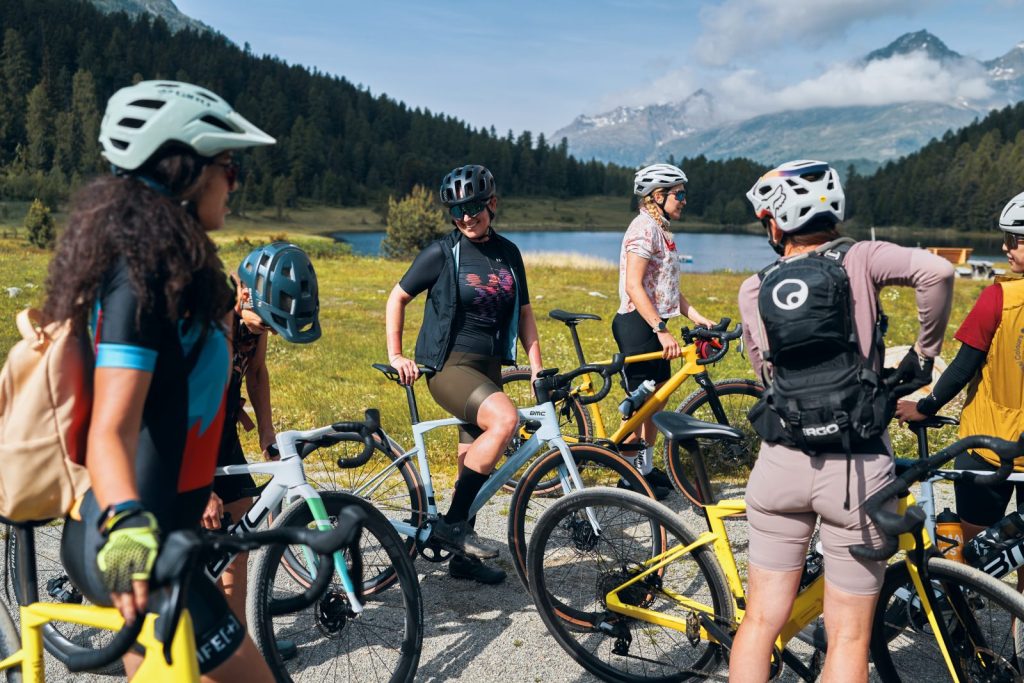
First up is the calm and sun-kissed little Lejda Staz (Lake Staz). A classic among the Upper Engadine lakes, this tantalising body of water (which can only be accessed on foot or by bike) lies nestled between St. Moritz and Pontresina in the middle of a wide, open clearing in the vast forest of Stazerwald.
Might I suggest you figure out a way to pack some bathers if you’re riding in the region in summer. Next up on our mini unpaved adventure is the endearing little town of Celerina.
Though lacking the flurry and clamour of its world-famous neighbour, this gem of a town has 320 sunny days on average per year and boasts the Church San Gian, which dates back to 1478.
Make sure to ride up the cobbled path at the front of this church and check out the striking gothic tower, which was hit by lightning in 1682.

A delicious tailwind blows us through the final stretch of the ride past unforgettable panoramic views. Yalke (from the Netherlands) is riding next to me for most of the way; the smile on her face stretches from ear to ear.
We pull into the enchanting town of Zouz and grab a quick drink from the water fountain in the main plaza before finishing up for lunch. As I pull up to the bus, I hand back my gravel steed with great reluctance. It was a magical day that could have gone on forever.
In the back of my mind I have already started to plan my next bikepacking adventure along the full length of the Inn Cycle Path.
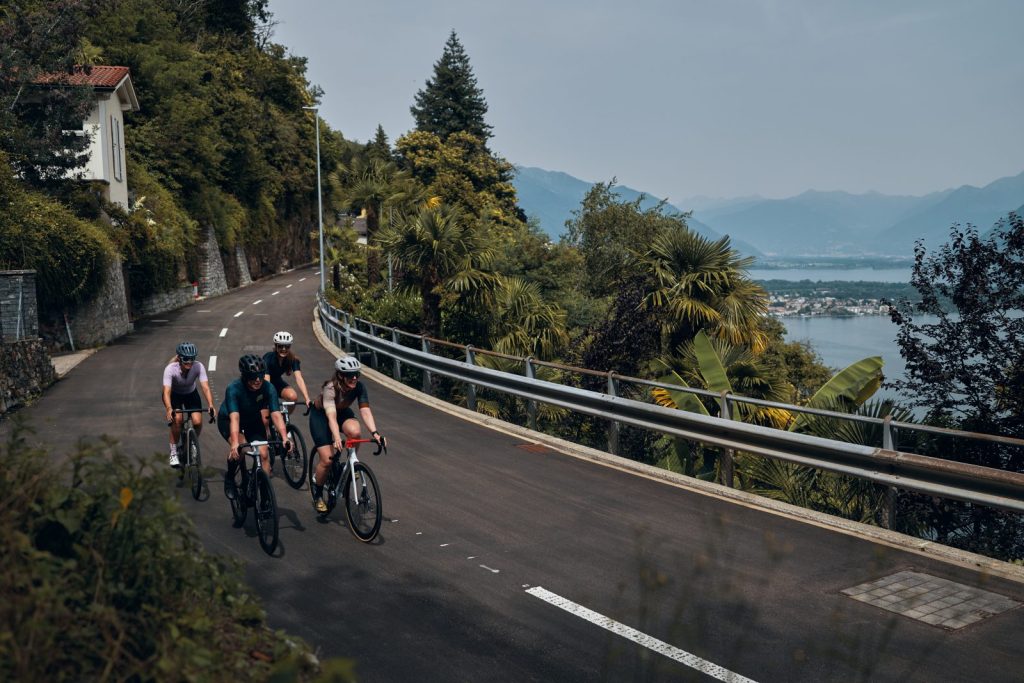
Day 3: Dolce vita cycling
Allow me to introduce you to Locarno: nestled on the edge of the Italian-speaking region of Ticino, this sun-drenched city boasts a glitterin glarge lake (Lago Maggiore) and an array of lush streets that zig-zag up and down the southern alpine-foothills.
Known for its dolce vita vibes, Locarno is the setting of our third day riding in Switzerland (and our first day on road bikes). Now, before we turn the pedals, let’s have a chat about this charming town and what it has on offer off the bike.
With its palm trees and much-hyped 2,300 hours of sunshine a year, Locarno’s near-Mediterranean setting has been swooned over by visitors since the late 19th century.

Switzerland’s lowest-altitude town is quite special, for sure, with an air of chic insouciance, a promenade strung along its mountain-facing lakefront and botanical gardens bristling with subtropical flowers and foliage. After a quick check-in, we are whisked away to dinner at Grotto America.
Is that a cutting board or a surfboard? That’s the first question that spontaneously comes into my mind when I see a cutting board loaded heavily with mixed sliced meats and cheese placed onto our table.
The owner of the restaurant fills our little boccalino mugs with locally sourced wine from Ticino before giving us the history of where we are about to feast. ‘A grotto,’ he says in English with a thick Italian accent, ‘is a nice weather restaurant. It’s a cave actually.
This place is 400 years old. We store wine and cheese and make risotto on the fire and eat it all under the trees by the river.’ Our culinary journey through history is accompanied by music coming from the Artists’ Corner. A natural stage and an open-air dance floor complete this wondrous evening under the stars.
The morning after we are back in lycra and ready to discover Locarno and surrounds on two wheels. I am excited to learn that our ride will be guided by Nicole Brändli (former pro cyclist, vice world champion and winner Giro d’Italia Women).
Our ride takes us down and along the banks of Lago Maggiore before climbing up to Tenero-Contra (a municipality of the district Locarno). From there we weave up and down nifty little climbs and oh-so-glorious descents before arriving in charming Ascona.
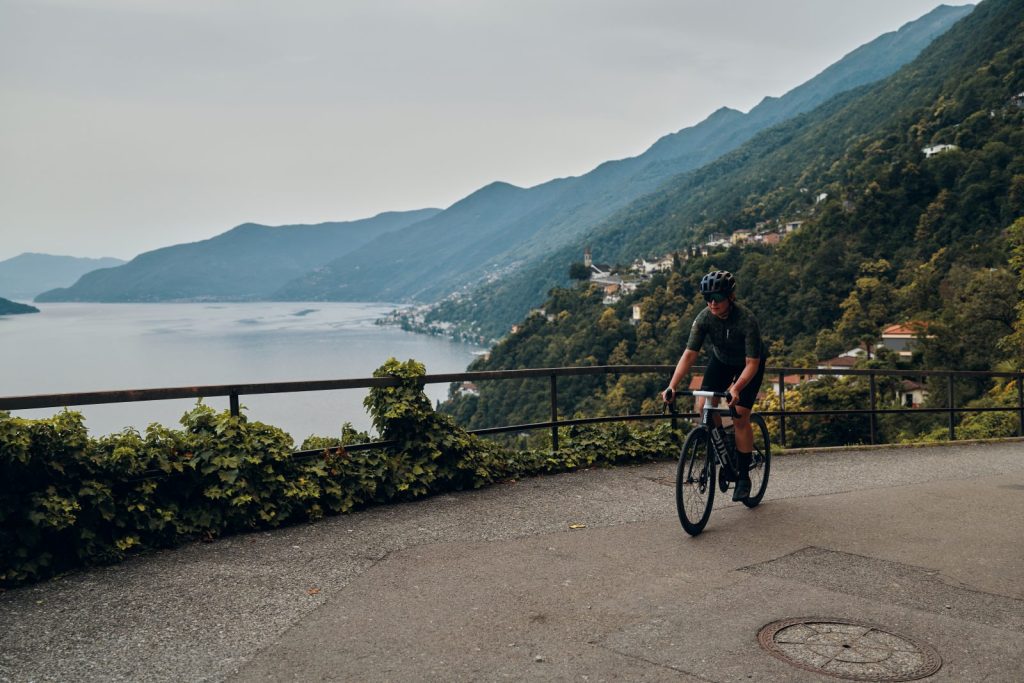
Sitting at 196 metres above sea level, Ascona is Switzerland’s lowest lying town and delivers lush roads with sweeping views of Monte Verità (known by the locals as ‘the place where our minds can reach up to the heavens’).
Soon enough we are back in Locarno and pedalling through its beautiful palazzos, through narrow cobblestone alleyways, past colourful houses and quaint eateries, and into its pedestrianised Old Town. Now, a word of warning: cycling in Locarno does require some grit.
Many of the streets are quite steep and cobbled and more often than not you are sharing them with cars and wayward travellers. Make sure to ride early (which also isn’t the worst idea if you’re there in summer and keen to avoid turning into a pool of sweat 10 minutes into your ride).
Day 4: The Paris-Roubaix of the Alps
Switzerland offers some of the best climbing in Europe, and yet it remains a relative hidden gem compared to the giants of France and Italy. If you call yourself a devoted cyclist then you can’t look past the superb roads and unspoilt scenery of Switzerland.
‘Oh, but I’m looking for legendary cols and climbs,’ I hear you say. Well, picture this: an extraordinary noodle of 24 tightly bunched hairpins that climb 932 metres in 12km – 7km of which are on granite stones dating back to 1827.
Now do I have your attention? This mythical cobblestone wonder of the cycling world that I’m speaking of is the St. Gotthard Pass climb via Airolo (better known as Tremola) and is our ride for our fourth day.
Topping out at 2,106 metres, the immense Gotthard mastiff is intimidating – even for ol’ mate Julius Caesar, who used to bypass this col for other easier passes.
Connecting the German-speaking Andermatt in the north and the Italian-speaking Airolo in the south, the legendary St. Gotthard Pass (also known as the Col du Saint-Gothard or Passo del San Gottardo) was opened in 1830, replacing the mule trackused by traders of old.
What truly distinguishes the Gotthard from any other legendary mountain pass in the world is its old cobbled road, or Tremolastrasse, through the Val Tremola or Trembling Valley from Airolo.

Known as the Paris-Roubaix of the Alps, Tremola has made several appearances in the Tour de Suisse as well as the Haute Route and is considered Switzerland’s longest historical road monument.
Having read up on the profile of this climb previously, I was feeling pretty good, as the program had us all on e-bikes for the ride up.
A tap on the shoulder the day before the climb, though, and I’m told that due to bike shortages the e-bikes would be given to the less proficient riders in our group and that I’d have to ride up this cobbled beast on my roadie.
Although I felt a little chuffed to be categorised as a proficient rider, I was mostly terrified at the thought of riding up this mountain pass on a rental roadiethat was one size too big and equipped with a semi-compact chainset.
After a quick stock up on food and water (and some deep breathing to settle my nerves) we set off towards the start of the climb. The first several kays are generally paved, but soon into time-honoured cobbles.
With great delight I note the smoothness of the Swiss-style cobbles and loosen my grip on the top of my handlebars. Curve after curve, slowly but steadily, I make my way up this serpentine road, which climbs at a steady average of 7.4%.
As my wheels bounce over the historic granite stones, I look down and watch the switchback spaghetti spilling down the mountain in front of the majestic backdrop of the Gotthard massif. I can’t help but give out a small little whoop as I realise I’m nearly at the top.
The last 5km of the climb are completely cobbled. My hands are slightly numb from the constant vibration. I can feel the crisp cool mountain air on my sweat-soaked jersey.
I turn the last switchback and hear a shout of encouragement from Maja (from Poland): ‘You are amazing!’ Fuelled by this much-needed roar of encouragement, I get up and out of the saddle and ride the last few hundred metres past a fluttering flag of a black bull on a yellow field.
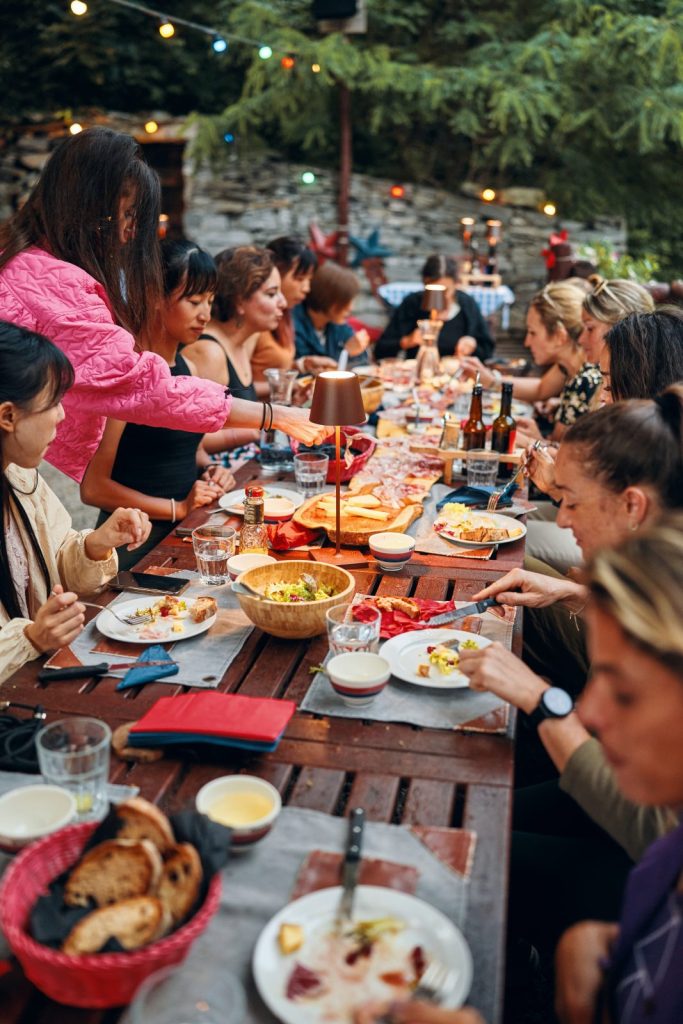
I’ve made it. A euphoric sense of joy and achievement settles in my chest. As I roll to the bus, I’m greeted by some of the women who were ahead of me, their faces beaming with glittering smiles. I quickly change into warm clothing and accompany the girls on wobbly legs towards our lunch spot.
On our way we notice Marta (Portugal) who has just finished the climb. She’s hunched over the handlebars, tears flowing from her eyes. ‘What’s up? You okay?’
I ask her. She smiles and replies: ‘I did it. I got up and I didn’t use it. Not once.’ She points to the top-tube control unit on her e-bike. Joyce, from Belgium, gives her a massive hug.
I rejoice in this amazing moment and am reminded of a famous quote by women’s rights advocate, Nellie McClung: ‘Never underestimate the power of a woman.’
I’ve climbed a lot of mountains over the years and seen some epic views on my various journeys to the skies but, I have to say, the phenomenal ride up Tremola was nothing short of magic. This mythical traverse is a work of art. Pretty stoked I conquered this cobbled beauty on two wheels.
(For those interested, the Strava segment can be found at strava.com/segments/4502555).
Day 5: Queen of the mountains
Here’s a little bit of cycling trivia for you. Question: how many non-pro women’s-only gran fondos are there in the world? Answer: just the one, and it’s located in and around stunning Gstaad, Switzerland.
Now in its third year, Le Rein (French for ‘The Queen’) is a unique amateur cycling race in Europe, open exclusively to women (or those who identify as women).
Although it is designed to be a competition (timing recorded for individual sections), La Reine website emphasises that it isn’t about defeating others but about challenging oneself. And let me tell you: it’s one hell of a challenge.
The race offers two well-thought-out distances – Gran Fondo, 136km and Medio Fondo, 87km – and covers the stunning landscapes of Saanenland, Pays-d’Enhaut, and the Gruyère region.
Keep in mind that the main Gran Fondo, which covers a leg-shattering 2,970 metres of vert, is considerably more than the ‘crowning’ stage of last year’s Tour de Suisse Woman (124km and 1,800 metres). Leading up to the day of the event I had decided I would tackle the Medio Gran Fondo.

I have several Peaks Challenges under my belt and, on any given day, Mt Hotham is my favourite mountain to climb, but this year my Melbourne winter training hadn’t really gone all that well and I was already feeling nervous about tackling the 1,800 metres of vert in the mini-version of this race.
As the week had progressed, the group had built a strong sense of comradery. Several of the women had planned to support each other and complete the distances together. Joyce and I were among these women.
Joyce had played an integral role in getting me up Tremola a couple of days ago, stopping ahead of me once in a while to shake her wonderful booty while yelling, ‘C’mon, put your ass into it!’ The day before La Reine she convinced me we should give the Gran Fondo a crack.
‘What if we ride it together?’ It wasn’t an offer I could resist as we had similar riding abilities and were able to make each other laugh.
The day starts early. We leave the hotel at 6:30am and make our way to the start line in the village of Gstaad. Located in the German-speaking section of the Canton of Bern in south-western Switzerland, Gstaad is nothing short of legendary.
According to local lore, it was God’s resting hand that shaped the illustrious hills and valleys of the Saanenland region where Gstaad is located. Indeed, divine intervention seems the only plausible explanation for such remarkable scenic beauty.
Known more for its exclusive ski resorts, come summer this multicultural village turns into a cycling paradise and offers a great selection of loops and local passes, which are all regular features in WorldTour races such as Tour de Romandie, the Tour de Suisse and even the Tour de France.
As the race start siren pierces the early morning air a procession of clicking noises begins as cleats meet clip-in pedals. The excitement is palpable. I smile at Joyce and we push off past the start line. The vert count starts immediately and does not relent.

Joyce and I sing, ‘Who run the world? Girls!’ at the top of our voices after each climb.
Twenty kilometres into the ride and we are greeted by our first of many long climbs: Mittelbergpass from Saanen, 10.2km long and bridging 647 vertical metres with an average gradient of 6.3%.
We reach the top of the ascent at 1,633 metres above sea level and inhale somedelicious porridge and apple juice before setting down a phenomenal 20km descent.
As we reach the turn-off for the Medio Gran Fondo, Joyce and I reconfirm our intentions to complete the Gran Fondo and invite into our fem-warrior fold another fellow rider from our tour group. Jiajia, who is from China, has very little experience riding long distances but makes it clear to us that she is keen on the Gran Fondo.
And so a Belgian, a Chinese and an Australian rider set off together for the second half of the big whopper.
Between the 40km and 80km mark we make our way through the undulating lands that offer all the Swiss clichés: cows, dairy farms, distant castles, mountain villages from another era, and a gorgeous ride through the vineyards of Chablais and Valais.
The last climb of the day is back-breaker. The little-known ascent of Yvorne to Lac Hongrin (12km, 1,100 metres) crosses a Swiss military base and snakes its way throughforests, a brief cliff stretch and a narrow and rough tunnel called Tunnel de les Agites before reaching Lac de L’Hongrin (The Hongarin Lake).
Joyce is waiting for me at the top of the climb. As we wait for Jiajia to join us, we cement our friendship by exchanging cycling war stories. There’s nothing like spending a long day on the bike with someone to build what is often an unspoken bond of understanding and filial affection.
After another tantalising descent we reach the end of the Gran Fondo. Joyce and I pat each other on the back as we ride past the finish line. Jiajia is not far behind us.
Feeling bewildered but oh so alive, I peel my body off the bike, grab a glass of champagne and sit my sorry bum on a bench in the sun. The La Reine was without a doubt one of the best rides of my life. An unforgettable experience that I hope more women from around the world can partake in.

100% complete
I stand next to Elke as she finishes her speech to the group. She thanks Switzerland Tourism for paving the way for lifelong friendships and then ushers me to speak. For a split second I remember a video I had seen recently of a woman riding a bicycle in Iran – an act that is forbidden and has severe consequences, but one which is being done in defiance of an oppressive and patriarchal system. As I address our dinner group, I note how special it is that we are being hosted by Switzerland Tourism, an organisation that promotes women’s empowerment. I acknowledge the fight for gender equality in Iran and across the globe and note our privileged position to ride in such wonderful settings, free from any persecution. I ask each of us to have perspective, be grateful and to spread the love while remembering that the rights of women are at the centre of life and liberty. I raise my glass to this amazing group and and say: ‘Woman. Life. Freedom.’
Dr Farinaz Zamani is a cyclist and human rights lawyer who is now home in Melbourne, still dreaming of the Swiss Alps

The writer’s rides
Our two-wheeled adventure was supported by BMC Switzerland. Over the course of five days, Farinaz had the privilege of riding three different bikes
Road – Teammachine SLR 01 TWO
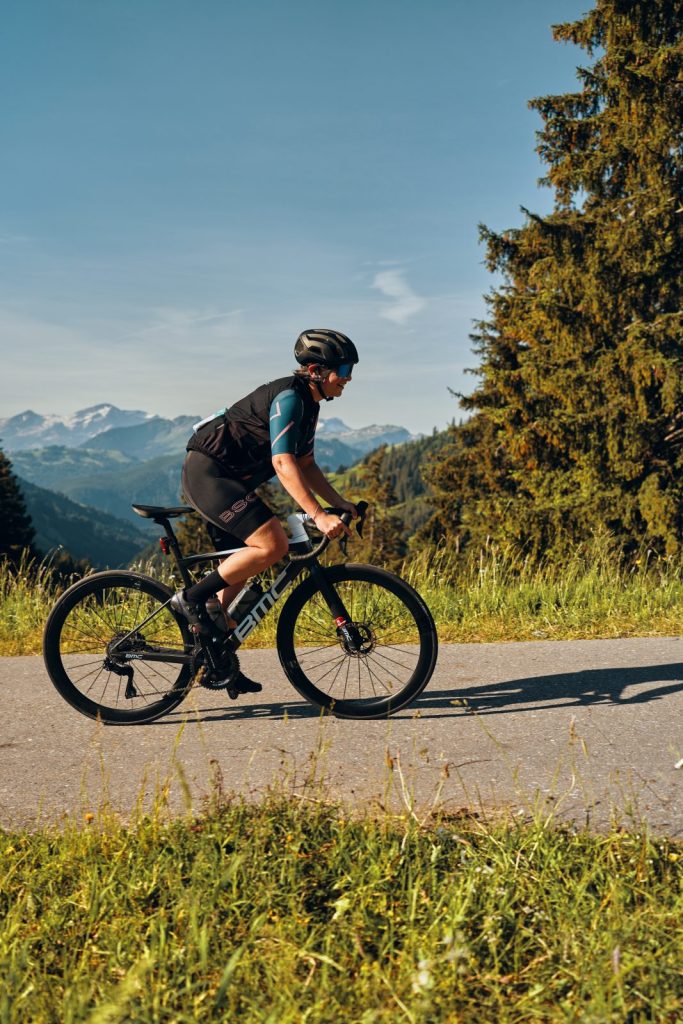
Launched in July 2020, this edition of the Teammachine SLR converges the best of both lightweight and aerodynamic worlds into a package that begs to be raced. Its TCC Race-engineered Premium Carbon frame incorporates the Aerocore Design system, ICS technology and Stealth Cable Routing.
This road bike combines exceptional speed, superior performance and unrivalled comfort.
Gravel – BMC Kaius 01
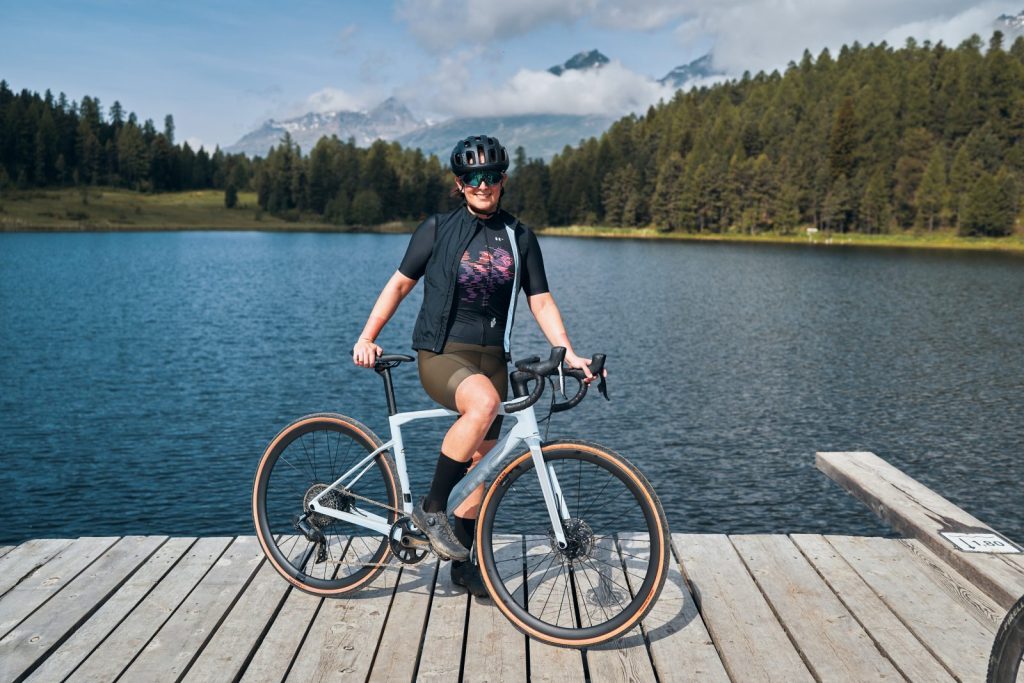
A premium carbon gravel bike designed to be your ultimate race companion. Engineered with an unprecedented carbon layup and gravel-specific geometry, it strikes the perfect balance of stiffness, lightweight construction and compliance.
It delivers optimal traction on loose surfaces, ensures front-end stability and offers unmatched climbing prowess.
Drawing on the precision and performance of BMC’s renowned road technologies, the Kaius 01 is a race machine finely tuned for thegravel experience. It features the engineered Kaius fork, the signature ICS Carbon Aero Cockpit, TCC Race compliance, compatibility with 1x and 2x drivetrains, and ample tire clearance of up to 44mm.
MTB – Fourstroke 01
The Fourstroke 01 sets the bar high as an exceptional XCO (cross-country Olympic) performance bike.
It’s equipped with Autodrop technology and APS dual-link suspension, featuring 100mm of front and rear travel, and its Premium Carbon frame provides integrated protection and is designed with the progressive BWC geometry.
The Fourstroke 01 offers the convenience of two water bottle mounts in the front triangle, making it ideal for long-distance missions.
By the numbers
136 – Kilometres ridden
2,975 – Metres of vertical climbing
500 – Swiss dairy cows with bells (two ofwhich nearly ran us off the road)
159 – Photos of breathtaking views
14 – Climbs with an average gradient above 10%
1 – Dark and treacherous 382-metre-long rocky tunnel
3 – Bags of Ovo swiss chocolate rocks consumed
250 – Women who participated in the 2023 La Reine Gran Fondo
Glacier 3000

If you find yourself in Gstaad and feel like a non-cycling activity, make sure to check out Glacier 3000. A famous ski resort, it has one of the longest ski seasons in Switzerland, is home to epic freeride terrain and guarantees snowy fun.
Glacier 3000 is served by a three-section aerial cableway from the Col du Pillon and Reusch passes to the Scex Rouge (2,940 metres abovesea level). The Dôme Hike is the highest point of Glacier 3000 at 3016 metres and is connected by a wide and comfortable path.
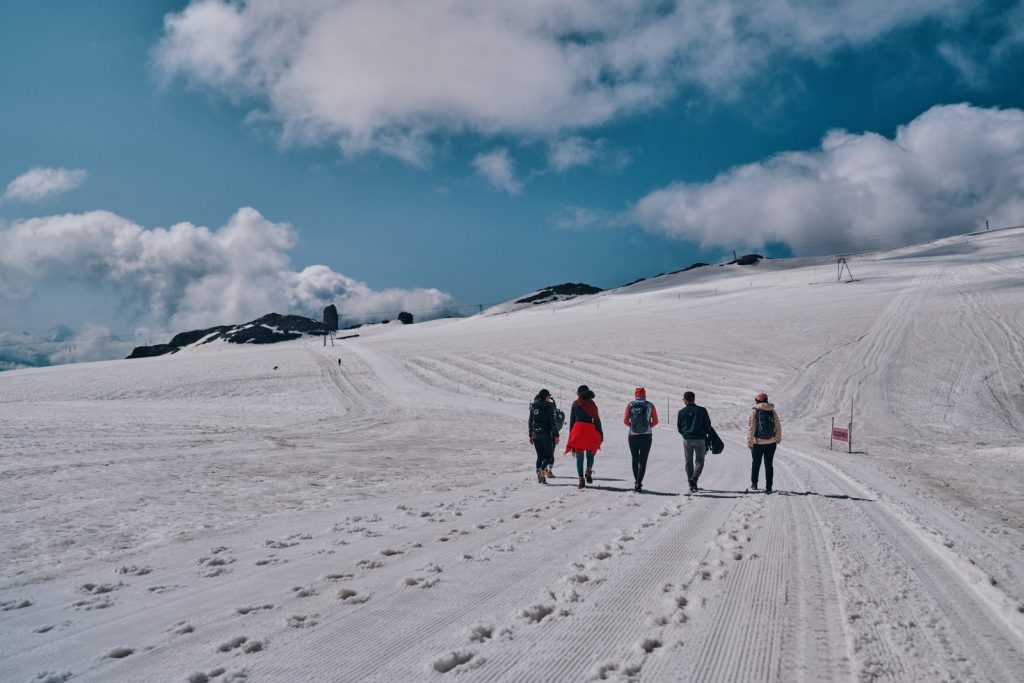
Make sure to check out the 100-metre Peak Walk by Tissot, which is the only suspension bridge in the world that connects two mountain peaks. Don’t forget to pack some waterproof shoes and warm clothing (even in summer the weather is temperamental so high up!).
Finally, don’t leave the Glacier without a visit to the Restaurant Refuge de l’Espace, which is located in the immediate vicinity of the Quille du Diable and offers a splendid view of the Derborence valley in Valais and the Bernese Alps.
Contemplate the breathtaking view from the terrace, savour the culinary delights made with regional products and let yourself be seduced by the majestic flights of the bearded vultures.
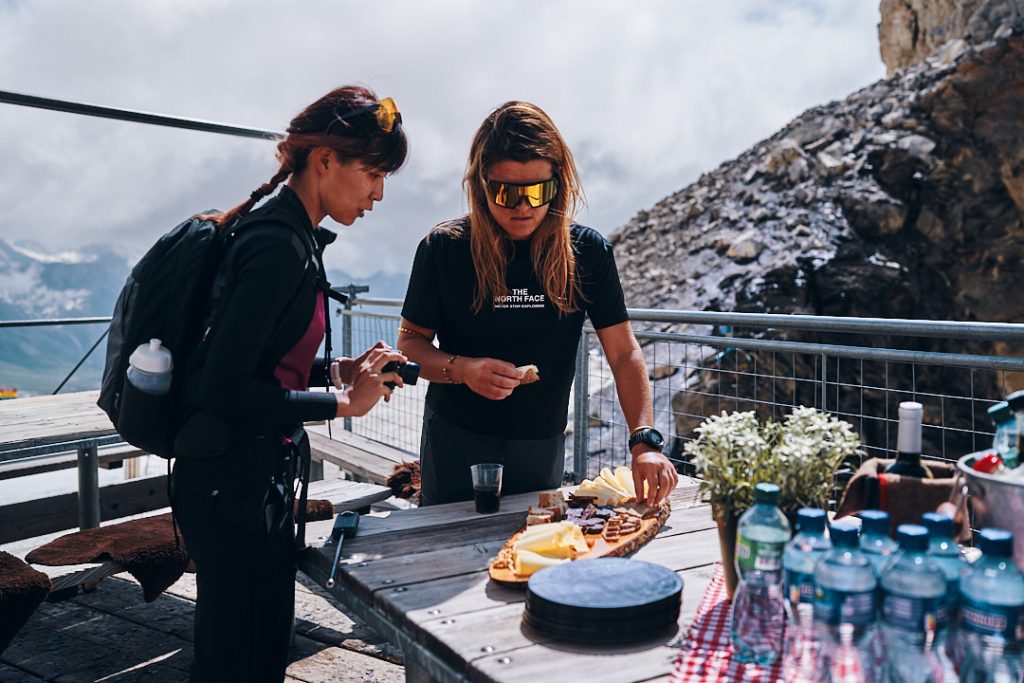
How we did it
TRAVEL
Generally, the best time to visit Switzerland is in the spring/early summer and in the early fall, April through June or September and October. This is when you’re unlikely to battle thick tourist crowds and enjoy some of the most pleasant weather. St Moritz, Locarno and Gstaad are serviced by several nearby airports.
I’d highly recommend flying into Zurich or Geneva and grabbing a flexSwiss Pass, which will set you back a pretty penny but will give you unlimited travel by train, bus and boat across Switzerland.
If you can opt for firsrt class so you can hitch a ride on the premium panorama trains which navigate heritage-listed train lines through the Swiss Alps, offering breathtaking views of the landscape.
ACCOMODATION
Switzerland has an abundance of ‘Bike Hotels’ and Switzerland Tourism has dedicated a website to all the various options available to the cycling tourists (bit.ly/3YXuPbB). Our arrival into the warmest town in Switzerland (Locarno) was made even sweeter with a stay at the Hotel Belvedere.
This fully renovated 4-star 130-year-old hotel offers rooms and suites with breathtaking views of Lago Maggiore, Locarno and the surrounding mountains and is connected to both the Church of the Madonna del Sasso and the lakeside via funicular.
Do what you need to do – sell a kidney if you have to – and book yourself a room in this grand hotel. You won’t regret it.
A special mention to our final stay in Gstaad at the wonderful Golfhotel Les Hauts de Gstaad & Spa, which boasts four restaurants and has a ‘sauna park’ – a whole section of the hotel dedicated to five different saunas and steam rooms that sit at different temperatures.
FOOD AND DRINK
Swiss cuisine is a tantalising blend of German, French and Italian culinary traditions, offering a rich tapestry of dishes from hearty cheese fondue and raclette to crispy rösti.
Known for its farm-to-table approach and high-quality ingredients, Swiss food is a true embodiment of Switzerland’s natural abundance and historical influences. A side note: if you’re in St Moritz, treat yourself to a romantic dinner at Romantik Hotel Muottas Muragl.
Sitting at 2,456 metres above sea level, the hotel and restaurant is easily accessible by a historic funicular dating back to 1907 and promises delicious food with a mesmerising backdrop of the Swiss alps.
THANKS
A humongous shout-out to Switzerland Tourism for hosting us and a very special mention to Sarah Haslebacher – a tireless, kind and wonderful guide who spearheaded the 100% Women Cycling Challenge (this was her baby!) and guided us on our six-day adventure in Swiss paradise.
I’d also like to acknowledge the photographer genius that is Florence Gross. Flo singlehandedly shot all 18 of us in different locations over the course of the week and produced the most stunning shots.
A final gracias to Black Sheep Cycling for kitting me out in their women’s WMN range.


